|
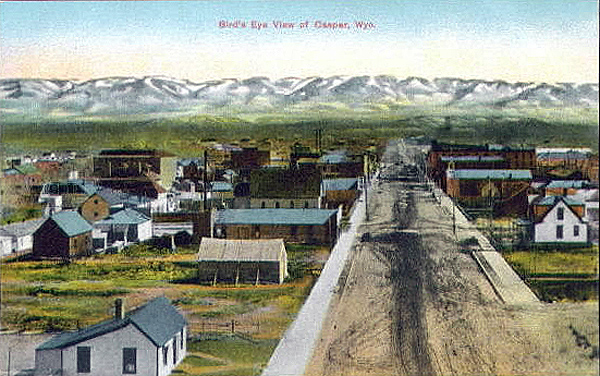
Looking South on Center Street toward Casper Mountain, approx. 1909.
The left-most two-story building in the above image is the back of the Odd Fellows Hall.
Deposits of asbestos had been discovered on Casper Mountain in the 1880's, but until the arrival
of the railroad, mining was not economically justified.
In addition to wool, oil and the railroad, growth of Casper was expected as a result of Charley Eads' mining camp on the top of Casper Mountain to the south of town. Mineral wealth was expected to
include gold, silver, lead, as well as the asbestos. Charley platted the town, Eadsville, in 1891 when it had but three cabins. A rush to the town occurred on the rports of rich copper deposits which would
warrant the establishment of a smelter financed by Denver capitalists. Several car loads of ore were shipped off to Omaha.
Back came the assay and a rush out of town was equally swift. A few intrepid miners held on for about five years seeking the promised silver and gold. Then they too
left town.
C. W. Eads previously was one of co-founders of Casper> On May 13, 1908, the Natrona County Tribune reported:
Charles Eads Goes to Pen.
C. W. Eads, who carries the reputation of
a successful horse theif [sic], will do
time m the penitentiary for a theft
committed in Big Horn county, of
which he has just been convicted. For
a number of years Eads operated in
the neighboring county of Fremont
and several attempts to convict him
were made in that county. None were
successful, so the horse owners along
the county line laid for their man and
finally caught him In a Big Horn
county horse stealing raid. His conviction promptly
followed, and during
the next few years he will be eliminated
from the elements which ranchmen
of that section are forced to combat.
Eads was a resident of Casper about
twelvey ears ago and at onetime owned
considerable property on Casper mountain,
the mining camp of Eadsville being named after him.
Others coninued to promote mineral wealth on Casper Mountain. Foremost among them was
Abram Emerson Minium (1862-1930), a former blacksmith and painter in a wagon works.Additionally he had previously
worked as an insurance salesman. The latter career may, however, ended abruptly when an insurance salesman bearing the same
name is believed to have jumped bond after an arrest for obtaining money under false
pretenses. See Corunna [Mich] Journal, Aug. 22, 1889, p. 2
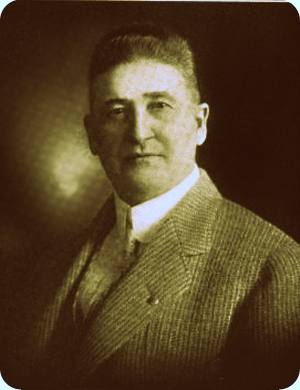 A. E. Minium, approx. 1911 A. E. Minium, approx. 1911
Minium first appeared in Wyoming about 1897 when he announced that he had on the north end of
Casper Mountain "made one of the greatest discoveries of gold-bearing rock yet discovered in
Central Wyoming, or perhaps in the state." Minium filed his claim which he called the The "Tillie Miller." A companion who verified
the Discovery filed an adjacent claim. Allegedly, the two began immediate work on the mines. A month later,
Minium sold a one-third interest in his Claim. The assays came in. The only one who made money was
Minium as a result of the sale of his interest in the claim.
A few years later with the news of the copper boom in Encampment and Hecla, Minium was displaying
copper samples and magnitite. Again after sale of interests, the promised copper came to naught.
About 1890 the usefulness of asbestos came to the fore with discoveries in Quebec. Fortunes were being made north of the border. Asbestos had been known
on Casper Mountain since the 1880's, but with the invention of fiberization of the asbestos. Asbestos became better than gold. Minium again promoted asbestos claims.
A fortune was to be made.
Funds were to be provided by capitalists. A corporation was formed, the United States Asbestos Mining & Fiberizing Co. capitalized at
$3,000,000. By 1909 four separate corporations had taken claims on Casper Mountain, with a total capitization between them of
$25,000,000. The big announcement came. The gullible again invested. Two small mills were actually constructed, one near Asbestos Springs on the top of Casper Mountain and
the other on Upper Smith Creek.
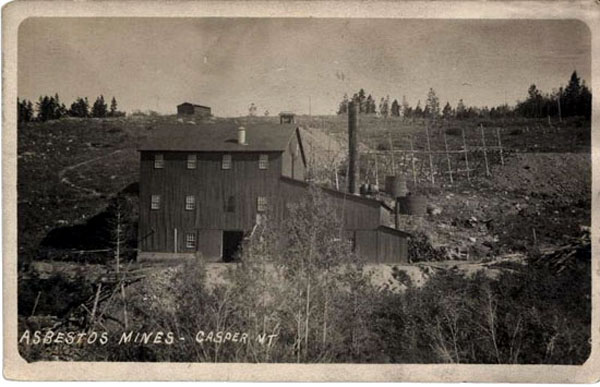
Asbestos Mine, Casper Mountain, 1911.
Glowing articles were written in numerous trade magazines as to the Casper Mountain asbestos. The articles written by
former Wyoming State Geologist H. C. Beeler failed to disclose that he was an officer of
Minium's companies.Favorable freight rates were promised. Announcements were made that
asbestos was actually being shipped.
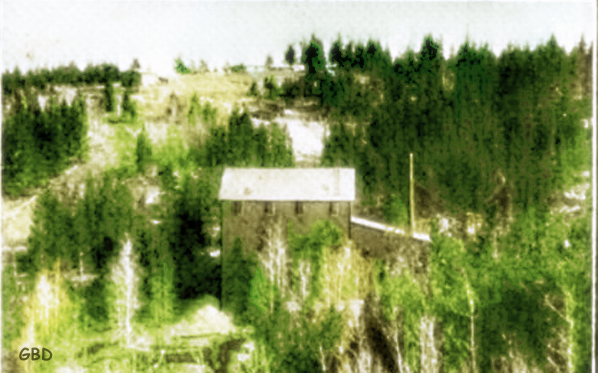
Abandoned Asbestos Mine, Casper Mountain, 1920's.
The difficulty with the asbestos mines was Minium in the construction of the mills on Casper Mountain and Smith Creek put the cart, or more properly,
the wagons before the horses. By the end of 1910, the ore house on Casper Mountain was allegedly full, see The Mineral Industry, Its Statistics, Technology and Trade During 1911, McGraw Hill Book
Company, 1912, p. 58. There was no way of transporting the asbestos down to Casper by wagon. The unimproved road was steep with dangerous
hairpin curves and switchbacks entirely unsuitable for transpotation by horse-drawn wagsons. Attempting the descent with a heavily laden wagon with a string-team would, in
essence, been terrifying. Mining was discontinued.
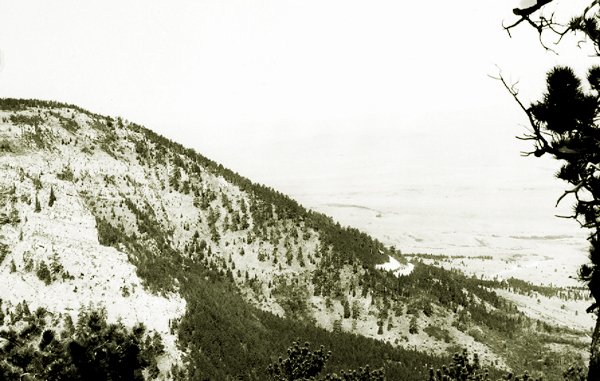
Distant view of three different hair pin curves and switchbacks snaking up Casper Mountain, undated..
After the mill was completed, one shipment of approximately of approximately 1700 lbs. was made to Lowell Lumber & Asbestors Co in Vermont for assessment. Lowell was America's leading
Asbestos processor. Mining World magazine reported that of the nearly 1700 lbs of asbestos tested, only 743 lbs was of a commercial
grade. The best grade, No. 1 bought $250 to $350 per ton. but No. 5 brought $10 to $25. The vast bulk of Casper Muntain asbestos tested was No. 5.
The magazine implied that the asbestos submitted for testing was cherry picked. The magazne noted that it
was "evident that the sample was carefully selected and that this rock is of much higher grade, both in quality and quantity, than the average rock as mined."
In short, the fibers in the Casper Mountain asbestos were too short and were brittle. They were commercially unsuitable for fiberization.
The report from Vermont should not have come as a surprize. In 1908, the Department of Interior, U.S.
Geological Survey, Mineral Resources of the United States, noted that on Casper Mountain the highest grades of asbestos were "practically absent."
In response to the lack of transportation, Minium suggested that perhaps
the company could construct an aerial tramway. As to lack of marketablity due to the low quality of the asbestos, the Company would create its own market
use the absestos (along with cement) by manufacturing fireproof concrete blocks in a plant it was acquiring in Denver. The plant was never opened.
A third difficulty was lack of fuel to power the plants. It was announced that the companies would construct a hyrdo-electric plant on
Smith Creek. Like the aerial tramway, the hydro-electric plant was never constructed.
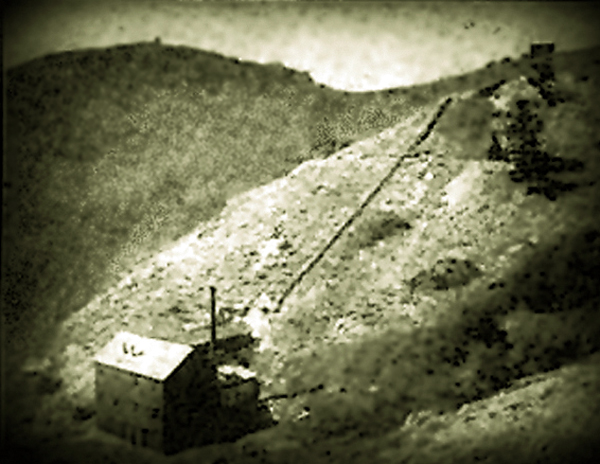
Asbestos Mill Smith Creek, approx. 1911.
In fact in 1911 little if any asbestos was mined or shipped. In 1912, he final blow to asbestos mining on Casper Mountain fell. Two articles appeared in
Munsey's Magazine:
The four asbestos companies mentioned, either singly or in combination, in the foregoing letters, are affiliated concerns which have not developed into successful commercial enterprises.
Some small expenditures were made at the mines by the North American
Company and by the Wyoming Company, back in 1906 or 1907, when
these concerns were formed; but their chief activities have converged
upon stock-selling, and not much has been accomplished in the way of
mining.
The moving spirit in the combination is A. E. Minium. Mr. Minium located
the original asbestos claims, and sold some property to the North American
Company and to the Wyoming Company. When these concerns got to the end of
their tether in selling stock, a portion of the Wyoming property was taken
over by the International Asbestos Mills and Power Company, a Minium
concern. This same promoter and his associates formed a new corporation
known as the Northwestern Asbestos Mills Company, which took over the
remaining portion of the Wyoming and all of the North American Company.
The whole aggregation of asbestos concerns, or near-asbestos concerns, has a very large nominal
capitalization, that of the North American being
$10,000,000; that of the International, $5,000,000; and that
of the Northwestern, $5,000,000. I do not find the capitalization
of the Wyoming Consolidated Asbestos Company stated anywhere, but I
have been informed that the authorized figure is again $5,000,000.
The two original concerns were acquired by the International and the
Northwestern companies on a lease and royalty basis. To complete the
circle, the North American, the Northwestern; and the Wyoming Consolidated
entered into some form of agreement whereby the International is to handle
the entire product of the mines—assuming, of course, that the asbestos
should prove of suitable quality and of sufficient quantity for commercial
use.
The article continued by noted that salesmen peddling the stock received commissions
of as mush as 50% of the selling price of the shares. The first article was followed up by a second.
The board of directors of the Minium companies met at the Inter-Ocean Hotel in Cheyenne and denounced the article.
In July 1912, a Federal Grand Jury indicted Minium and his associates for using the mail to defraud.
While the case lingered for the next four years in the United States District Court,
a new corporation, the Midwest Asbestos
Company (unrelated to the oil company), was incorporated in Arizona. Through stock swaps, the property on Casper Mountain was transferred to
the new corporation which then commenced sales of stock with the promise that a plant would be opened in Denver for the manufacture of
asbestos shingles and blocks; that two or three cars of asbestos were being shipped out every day
from the mines at Casper; that a railroad was being constructed to the mines; and that the company and was regularly paying 8% dividends.
In Kansas one poor farmer
was convinced to purchase stock with borrowed money. When the expected dividends were not paid he travelled to
Denver. There he discovered the mines were idle and that the company had nver paid dividends. See Beachy v. Jones, 195 P. 184 (Kan. 1921); the Mining
Investor,March 2, 1914.
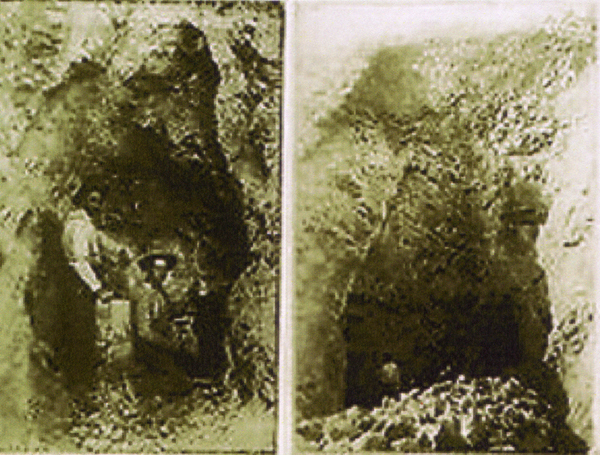
Asbestos mine, Casper Mountain, approx. 1911.
In July 1916, Minium plead guilty to the charge of using the mails to defraud shareholders.
See , March 31, 1916. In the period 1913 to 1919, A similar pattern was followed by Minium with regard to asbestos claims in Atlantic City and near Lander. With regard to both,
claims were made of shipments of asbestos, including an anouncement that one shipment had been made to
Japan, and plans for construction of asbestos plants in Denver.
In 1913 Asbestos had been discovered near Globe, Arizona in
Ash Canyon by T. D. West and Fred Patee. Patee from Denver had previously been the owner of a mica mine near Fox Park The asbestos fibers in Arizona were of a superior quality and
the ore brought top dollar. Not withstanding the difficulty of transporting the ore (it had to be packed out on the backs of donkeys to Globe 40 miles away) the
operation was a success and was sold by West and Patee to Johns-Manville in 1916. Johns-Manville switched to motor trucks.
In 1920 Minium appeared in Globe apparently to take advantage of the boom in asbestos mining. He announced that he in his new operation would
eliminate the high expense of transporting the asbestos ore though the use of blimps each of which could carry two tons of the ore..
See Engineering and Mining Journal, Jan. 24, 1920. In 1921, newspapers across the
American West reported that Minium had been arrested in Arizona on charges brought in Chicago relating to fraud with
regard to the promotion of the American Fireproofing & Mining Company previously headquartered in Lander in a building later used as
a garage. Notwithstanding the
charges, Minium was not extradited back to Illinois. See Tombstone Weekly Epitaph, Oct. 30, 1921, p. 2.
The charges, however, apparently ended Minium's career as an asbestos promotor. His claims near Globe were sold at a
sheriff's sale.
In 1930, Minium was hospitalized in Denver where he had been residing in a
lodging house. He was interviewed by a reporter for INS who quoted Minium:
. "On account of the scandal," Minium said, "my wife divorced me. I have nobody." The story noted that A fraternal order of
which Minium is a member plans to aid him when he is discharged from the
hospital. "But. it won't he for long." the former 'Asbestoss King,' declares confidentlv. "Prettv soon my invention " and his eyes sparkle as
his imagination runs off with him., as he asserts he has developed a new kind of
machine for separating gravel in dry placer mining.
The reporter continued: He is vague regarding his activities since his arrest nine years ago in Globe, Ariz.,
in connection with the investigation of the American Fireproofing and Mining
company of Chicago, of which he was head. He was released without trial,
he said. Minium denies any crookedness on his own part, though notoriety
attended his business deals throughout his career and he was convicted of
using the mails to defraud. "That was just a frameup by people who had it in for me," he explained. "When I was
arrested, I didn't have much ready money. I had made a fortune in asbestos,
all right, but I had put a fortune back into it." The reporter continued that in the Chicago asbestos
scandal it was charged although the reputed capital of the company was more
than sixteen million dollars, only $3,000 worth of asbestos had been mined in
three years. Several months later Minium died. About a month following his death, a patent was issued for
a braking mechanism for motor cars.
Beginning about 1908 the danger of inhaling microscopic asbestos fibers was noticed by
writers in Britain. From 1930 to 1933, Mis Majesty's Stationery Office published several reports noticing the
hazardous nature of asbestos. In 1933, Johns-Manville settled asbestos claims by its employees and closed down its
asbestos operations near Globe
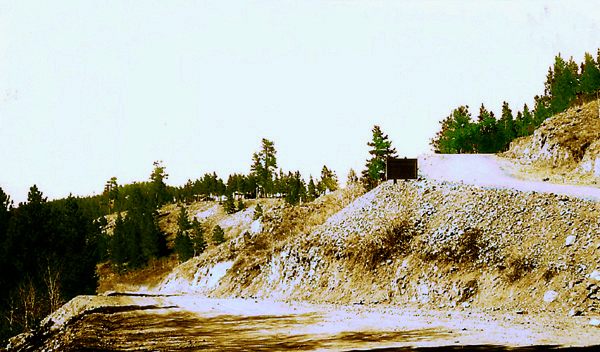
Motor Road at top of Casper Mountain, undated.
Next Page Fred Patee unsuccessfully attempts to breath life into the asbestos
business on Casper Mountain.
|